
Date: July 6, 2021
Location: Lat: 33.67644°, Lon: -52.99544°
Dive depth range: 2,382 - 2,640 meters (7,815 - 8,661 feet)
Access Dive Summary and ROV Data
While exploring “Hopscotch” Seamount during Dive 03 of the 2021 North Atlantic Stepping Stones expedition, we encountered several of these rather large glass sponges. The tissues of glass sponges contain glass-like structural particles made of silica. The many tiny siliceous elements of a glass sponge’s skeleton are called “spicules.” Unlike soft sponges, glass sponges produce extremely large spicules that fuse together in beautiful patterns to form a hard structure. These sponges live attached to hard surfaces and consume small bacteria and plankton that they filter from the surrounding water. Video courtesy of NOAA Ocean Exploration, 2021 North Atlantic Stepping Stones: New England and Corner Rise Seamounts. Download largest version (mp4, 102 MB).
This hermit crab was on the move! It was spotted crawling over a sea star in the genus Henricia. In lieu of the commonly thought of shell on its back, this hermit crab was carrying an anemone on its back. Video courtesy of NOAA Ocean Exploration, 2021 North Atlantic Stepping Stones: New England and Corner Rise Seamounts. Download largest version (mp4, 9.7 MB).
On July 6, we conducted the third dive of the 2021 North Atlantic Stepping Stones expedition on a previously unexplored seamount the expedition team dubbed "Hopscotch" Seamount, as its exploration brought us just south of the Corner Rise Seamounts initially targeted for exploration on this expedition.
The geology of the seafloor transitioned throughout the dive as we moved upslope. We started on a heavily sedimented area before encountering ferromanganese-coated pebbles that eventually became large enough to host coral and sponge communities. From there, we moved to vertical slope of mostly unsedimented volcanic flow morphologies dominated by pillow lavas.
Biologically, this area was much more diverse than the first two dives of the expedition. We observed at least six species of sponges and four different species of bamboo corals as well as several other species of coral, zoanthids, and sea pens. Other animals encountered included tube anemones, sea stars, snails, amphipods, and one lonely sea cucumber, to name a few.
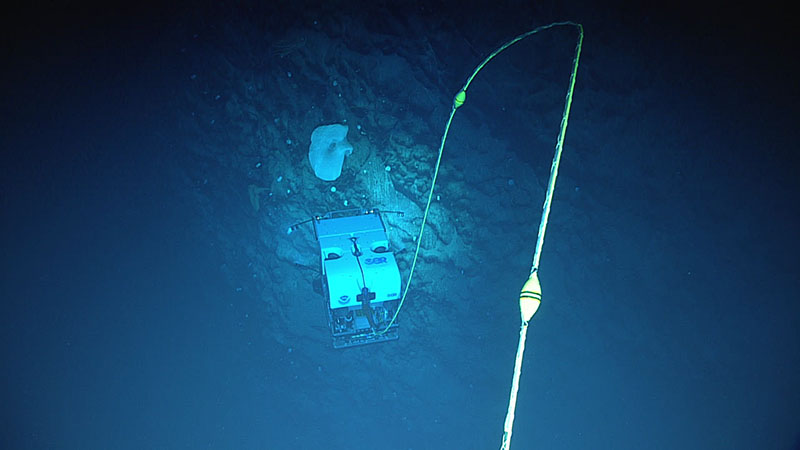
During Dive 03 of the 2021 North Atlantic Stepping Stones expedition, we saw several very large glass trumpet-shaped sponges, some that were well over a meter (three feet) in height. In this image, remotely operated vehicle Deep Discoverer images one of the sponges; for reference, Deep Discoverer is 2.7 meters (9 feet) tall! Watch a video of one of these sponges. Image courtesy of NOAA Ocean Exploration, 2021 North Atlantic Stepping Stones: New England and Corner Rise Seamounts. Download largest version (jpg, 402 KB).
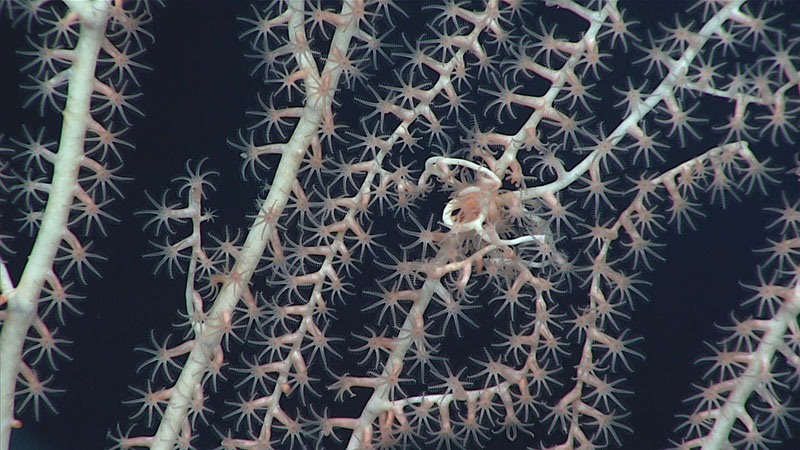
Note how the branching pattern of this bamboo coral near the center of the image is different from elsewhere on the coral. This is due to a small anemone living on the coral, causing the coral to create small, basket-like branches around the anemone. We observed these anemones during Dive 02 of the 2021 North Atlantic Stepping Stones expedition and collected a sample for identification and documentation purposes, as the relationship between the anemone and its coral host is not well understood. Image courtesy of NOAA Ocean Exploration, 2021 North Atlantic Stepping Stones: New England and Corner Rise Seamounts. Download largest version (jpg, 1 MB).
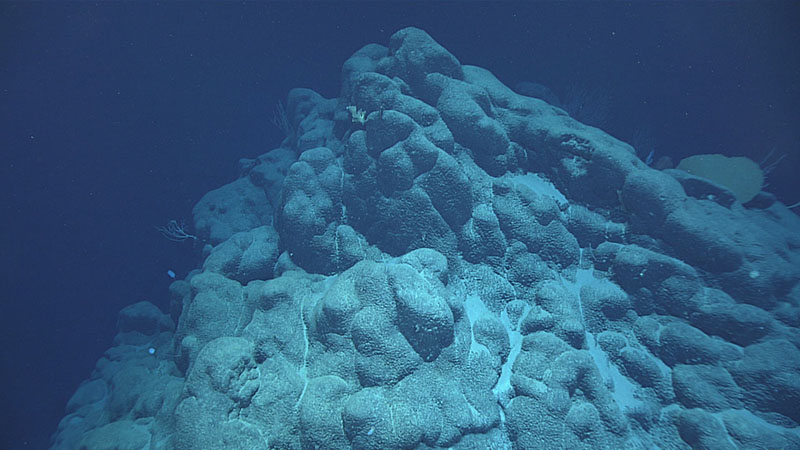
Much of the seafloor during the middle part of the third dive of the 2021 North Atlantic Stepping Stones expedition was dominated by these impressive pillow lavas with extensively developed botryoidal (or bubbly, grape-shaped) ferromanganese crust textures. These crusts precipitate slowly out of the water column over time at a rate of one millimeter per million years. Image courtesy of NOAA Ocean Exploration, 2021 North Atlantic Stepping Stones: New England and Corner Rise Seamounts. Download largest version (jpg, 867 KB).

This delicate hydroid was one of many observed attached to a dead coral stalk at a depth of 2,616 meters (8,583 feet) while exploring “Hopscotch” Seamount during Dive 03 of the 2021 North Atlantic Stepping Stones expedition. Belonging to the class Hydrozoa, hydroids are cnidarians, related to corals, sea anemones, and jellies. Image courtesy of NOAA Ocean Exploration, 2021 North Atlantic Stepping Stones: New England and Corner Rise Seamounts. Download largest version (jpg, 746 KB).
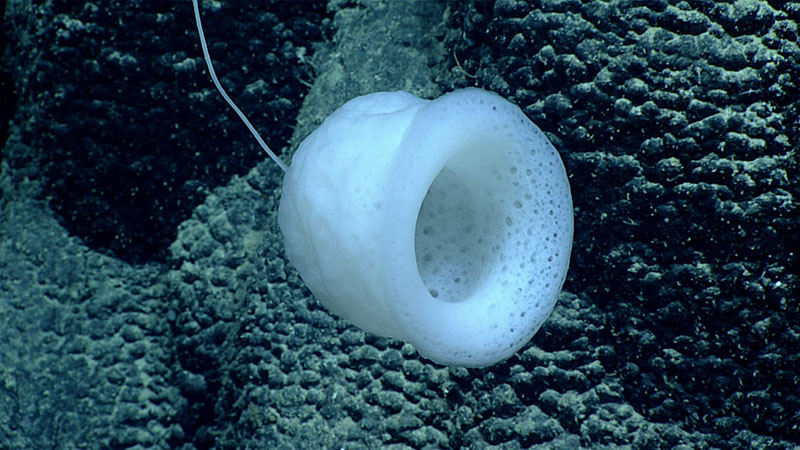
A glass sponge seen attached to a rocky wall. We saw several of these walls covered with a diversity of sponges during the third dive of the 2021 North Atlantic Stepping Stones expedition. Image courtesy of NOAA Ocean Exploration, 2021 North Atlantic Stepping Stones: New England and Corner Rise Seamounts. Download largest version (jpg, 1 MB).
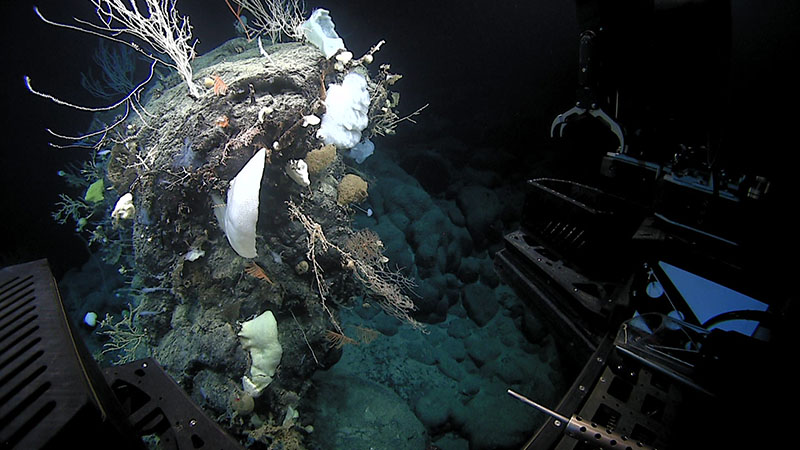
Large boulders covered in life were seen throughout Dive 03 of the 2021 North Atlantic Stepping Stones expedition once we transitioned out of the sediment zone during the initial landing. This rock has multiple species of coral and sponges associated with it. Image courtesy of NOAA Ocean Exploration, 2021 North Atlantic Stepping Stones: New England and Corner Rise Seamounts. Download largest version (jpg, 778 KB).
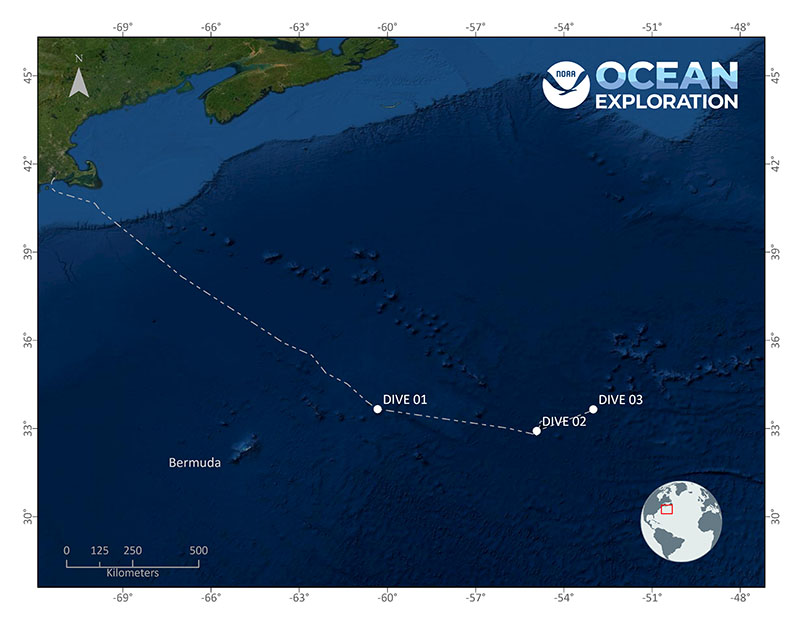
Location of Dive 03 of the 2021 North Atlantic Stepping Stones expedition on July 6, 2021. Map courtesy of NOAA Ocean Exploration, 2021 North Atlantic Stepping Stones: New England and Corner Rise Seamounts. Download largest version (jpg, 2.4 MB).
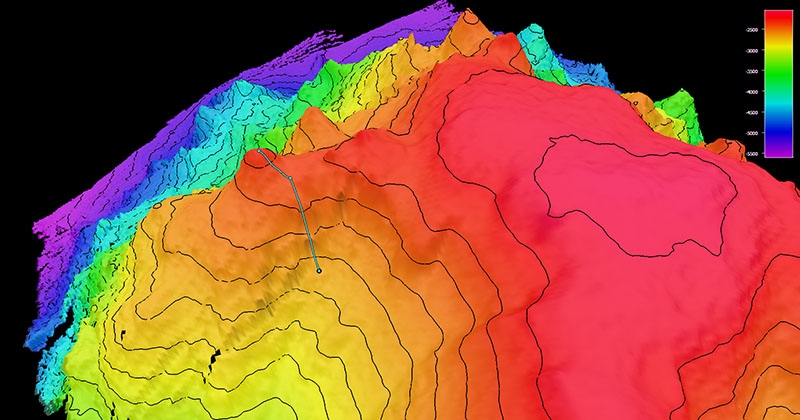
Image showing the dive track of Dive 03 of the 2021 North Atlantic Stepping Stones expedition. Scale is water depth in meters. Image courtesy of NOAA Ocean Exploration, 2021 North Atlantic Stepping Stones: New England and Corner Rise Seamounts. Download largest version (jpg, 768 KB).